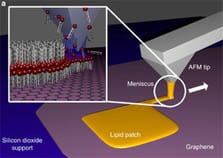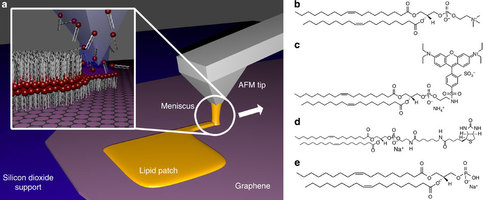Writing Artificial Cell Membranes on Graphene


(a) Scheme of the writing process and (b–e) the phospholipids used in our study: (b) the main constituent of the phospholipid ink used as carrier, DOPC and three functional admixtures (c) the fluorescently labelled Liss Rhod PE, (d) the biotinylated Biotinyl Cap PE and (e) the negatively charged DOPA.
Researchers at Karlsruhe Institute of Technology are reporting on a breakthrough in creating artificial cell membranes on graphene. Using Lipid Dip-Pen Nanolithography, the researchers demonstrated that cell membranes can be written on graphene the same way ink is used to write on paper.
The cell membrane is a complex phospholipid bi-layer that covers every cell in the human body. It is dotted by hundreds of proteins, chemicals, molecules and ion channels that help the cell play its part in functioning of the entire body. It has so far been extremely hard to study the functioning of the cell membrane. Hence, researchers at Karlsruhe lead by Dr Aravind Vijayaraghavan, and Dr Michael Hirtz began the search for an alternate way to study these membranes. Graphene’s properties make it ideal for creating artificial membranes. It unique electronic and semi-metal conductive properties provide phospholipids with an ideal material to spread uniformly.
Using a very sharp tip with a quill pen like tip in the range of several nanometers, multiplexd lipid membranes were written on the graphene surface. The researchers were able to mimic the details of a real membrane right down to the nanoscale by precise control of the machine handling the nanometer phosphoipod pen.
According to the paper reporting the findings in Nature, the researchers were able to show that the lipid layer produced on graphene was able to bind with the protein streptavidin at biotin binding sites. This is similar to the outcome seen on live membranes, paving way for potential applications in drug screening, understanding biological processes and disease detection.
Also Read: DNA Used to Assemble Graphene Transistors
